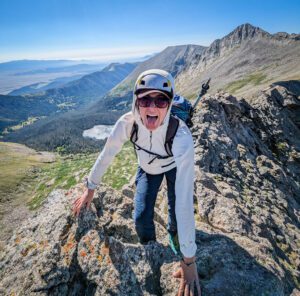Last Updated on November 19, 2021 by foxintheforest
The hiking in the desert brings otherworldly landscapes right to your fingertips. This harsh, unforgiving landscape truly defines what it means to let life hang in the balance. However, before you head out into this incredible landscape, there are a few things you need to know about desert hiking.
As an expert in desert travel, both on-trail and cross country, I’ve learned a thing or two about how to survive in this unforgiving place. In my five years of hiking in the desert, I’ve even had to learn a few things the hard way (oops!).
About this Comprehensive Guide to Desert Hiking
When it comes to desert hiking, I’ve got you covered with a comprehensive look at everything you need to know to hit the sandy trail.
We’ll cover a variety topics about hiking in the desert so you can be fully prepared for your big desert adventure. Here’s a look at what to expect about this desert hiking guide:
- The best time of year to hike in the desert
- Things to pack for your desert hike
- Expert desert hiking tips you need to know
- Additional resources for planning a desert adventure
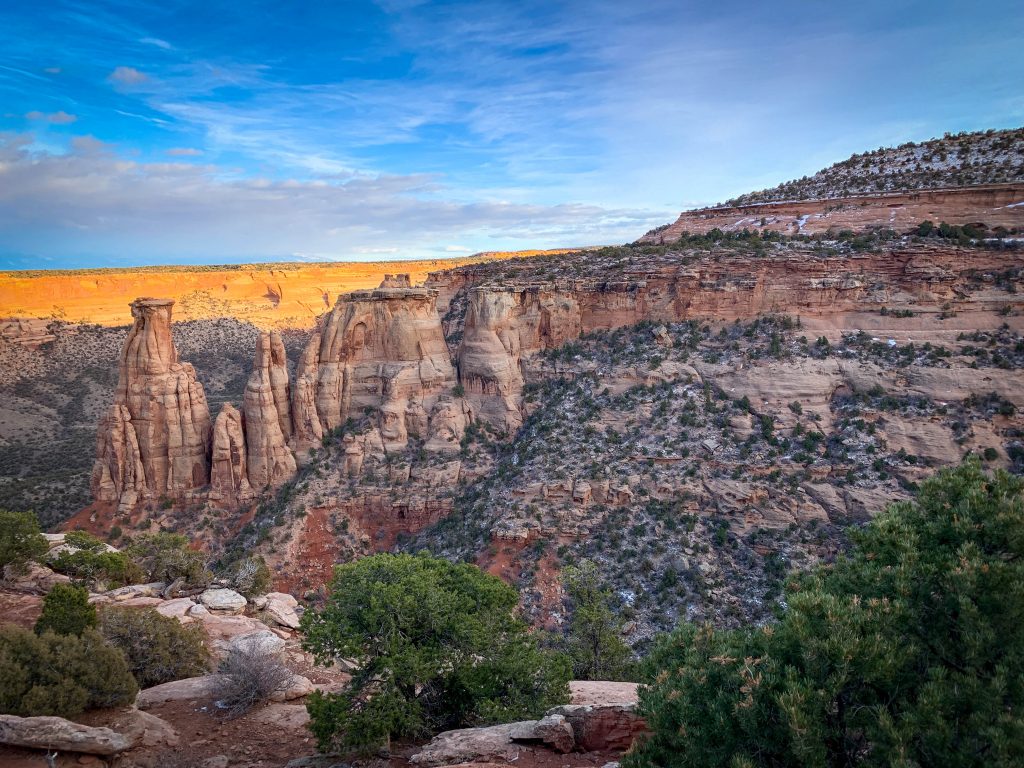
When is the Best Time to Go Desert Hiking?
Choosing the best time to go on a desert hike depends on two factors, the season, and the local weather. First, never go desert hiking in canyons if the weather forecast calls for rain. Flash flooding is a real threat, and it can quickly kill you, so avoid hiking in slot canyons or other canyons in the rain.
So if we assume there are sunny skies, when should you go on a desert hike? Spring and fall are the best times for desert hiking. The weather isn’t too hot (like it is in the summer) or too cold (like the winter months).
Desert hiking in the winter can be a real treat – snow-dusted sandstone formations are an unbelievably beautiful site but keep in mind it will be cold so pack accordingly.
Summer often provides the best opportunities for kids to travel to the desert, but it’s also unbelievably hot. Desert sandstone acts like a furnace, reflecting heat right back towards you. Desert hiking during the summer isn’t really recommended, but lots of people do it anyway.
What to Pack for Desert Hiking?
You should always pack the Ten Essentials for any hiking objective. But when it comes to hiking in the desert, you’ll want a few extra items in your hiking pack. Here’s what to bring.
- Sun protection. Think UPF, long-sleeved clothing, sunscreen, sunhats, SPF rated lip balm, sunglasses, the works.
- Extra food. Don’t forget to pack plenty of salty snacks to replenish your salts!
- Headlamp and batteries. This is an essential item, especially for long-distance desert hiking.
- A first aid kit with tweezers. Tweezers are a life-saver if you accidentally bump into a cactus. (I love the Adventure Medical Kits Mountain Series)
- Extra socks and a blister kit. Sandy terrain can seep into your footwear and cause game-ending blisters. Extra socks help keep your feet in tip-top shape.
- Extra layers. For as hot as the desert is during the day, it can get just as cold at night.
- GPS, map, and compass. GPS devices don’t work well in canyons, while desert maps aren’t that detailed for open cross-country travel. Know how to fluently use both.
- Plenty of water. You’ll want to carry at least 2 liters, likely more for big mile days. Bring a filter too! We’ll talk about hydration later. Learn how to choose a water filter for hiking and travel.
- A damp cotton shirt in a plastic zippered bag. Create your own air conditioner for super-hot days. We’ll talk about this hack below.
- A pocket knife and fire starter kit. Always handy in emergencies.
- A buff or lightweight neck gaiter. Not only gives you added sun protection, but it also comes in handy if the wind picks up and creates a dusty scene.
- Camera and spare charge pack. Just in case!
- Poop kit. Poop doesn’t break down in the desert, so always carry a wag bag for emergencies.
- A pack to carry everything in. I love my REI Flash 22 for desert adventures. It’s lightweight and provides enough room for the above items.
- A light emergency bivvy. I love this SOL Emergency Bivvy. It’s super affordable ($17), lightweight, and compact. Perfect for the unexpected emergency.
- Emergency Beacon (optional, strongly recommended). The desert is a super-remote place. Even while camping in the desert you can be hours from the nearest cell phone reception. I love my Garmin InReach Mini for desert hiking.
- Hiking poles (optional). I only recommend hiking poles for cross-country travel. They aren’t too useful in slot canyons or canyon travel. Here’s how to choose the right pair of hiking poles for your adventure.
Expert Tips for Hiking in the Desert
Now that you’ve got a plan and a packing list, it’s time to dive into everything you need to know to go on a desert hike. These desert hiking tips are designed to give you the insider skills you need to stay safe in the desert. I even added a few handy hacks for staying cozy in the brutal desert heat.
1. Cover Up
It might be tempting to let it all hang out in your sports bra and short shorts, but when it comes to desert hiking, you want to stay covered as much as possible, save that nakedness for camp!
The sun is relentless and by exposing your skin to the sun, you’ll risk getting burned (ouch), or collecting a lot of dirt when you sweat, which can cause sores from dirty bare skin rubbing against your pack.
Avoid unwanted sunburns by wearing an ultra-lightweight sun shirt and lightweight, convertible hiking pants.

2. Pack a Wet T-Shirt
Remember how I said to pack a damp cotton t-shirt in a baggie? During the hottest part of the day swap shirts for a DIY evaporative cooler. You’ll feel like you’re wearing an air-conditioner. This little luxury is a great way to cool off on a desert hike. However, if you start to feel your pack rub, change back to your dry shirt to avoid chaffing.
3. Don’t Forget About the Cold
Most people associate the desert with heat, but the desert can feel just as cold as it does hot. Always pack a few cold-weather layers for any desert trip.
If you’re traveling in winter, you’ll want all the layers you can get. This lets you mix and match for ultimate comfort. Don’t forget hand and toe warmers too.
Related: Amazing Hiking Clothes for Women on Any Budget
4. Avoid Desert Hiking During the Hottest Part of the Day
Temps quickly rise in the desert. While desert hiking it’s really easy to overheat, get dehydrated, and succumb to heat exhaustion or even get heatstroke. Here are a few ways to combat desert heat.
If you’re out on a hot day, plan your desert hike to avoid the mid-day heat. Know if and where the shade will be before you set out (check out a map of your route) and plan to find shade by the time the sun is at its apex.
The best way to avoid the hike while desert hiking in the summer is to start hiking before the sun rises. Once the landscape starts to feel like an inferno, take a siesta in the shade for several hours. Start hiking again in the evening, after the sun has lost its intensity.
Pro Tip: The best way to avoid dangerous heat is to hike in the late fall through early spring months. Summer is a dangerous time to hike in the desert and the risk of dehydration and heat stroke are real.
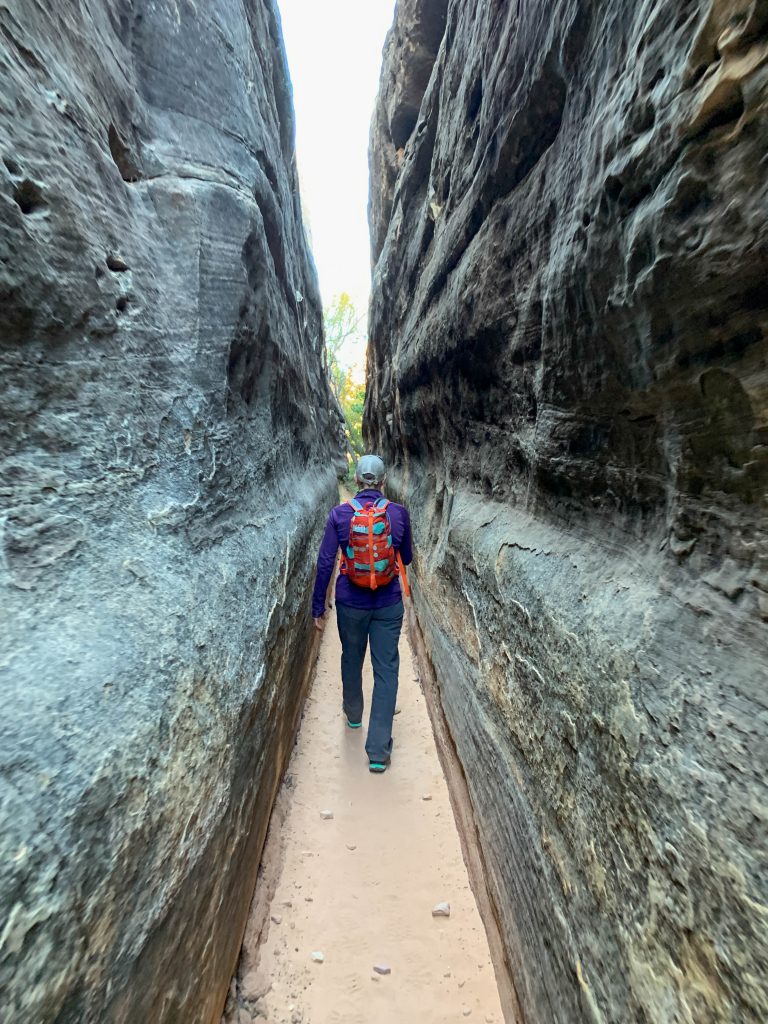
5.Seek Shade
Along the lines of planning your desert hiking day, you also want to seek shade for breaks. This can be under a mighty juniper tree, behind a rock, or on the shady side of a canyon. If you can’t seek shade, you can build shade with a rain/wind jacket, a hiking pole, and a couple of heavy items from your pack.
6. Hydrate Up
The most obvious desert hiking tip is to make sure you’ve got plenty of water. Take at least 3 liters for a day hike, or even more. Water weighs a lot, so it will feel like a burden, but if there are no reliable water sources, you’ll have to carry the weight.
Pro Tip: Hiking in summer? Budget one gallon per person per day at a minimum. Carry more water in your car.
Keep a water filter handy and check for potential spots to fill up along the way. Research your hike and always check in with the local ranger station to get updated info on seasonal water sources. If you’re out for the day, keep water in the car so you can return empty.
7. Don’t Waste Water
Again, another obvious tip, but water is a precious commodity in the desert. Never waste water while hiking, camping, or exploring. Drink it up first!
When refilling at water sources, take only what you need and be careful not to spill. Many creatures depend on these precious water sources. Don’t forget to double-check with authorities that you can actually use water sources. Many are off-limits to humans and pets! If you find yourself with extra water at the end of your trip, you can always water plants nearby.
8. Salty Desert Hiking Snacks
Replenishing your salt stash is just as important as staying hydrated. Drinking electrolytes also helps combat dehydration and keeps your salt reserves up. In fact, you can actually get rather sick from drinking too much water and not restoring your salt intake. Here are a few of my favorite salty snacks to take hiking:
- Nuun Hydrate. Plop a Nuun tab in a water bottle for an easy re-up on important electrolytes.
- Chips. The saltiest you can find. YUM!
- Salted nut mixes.
- Salted Trail Mix
- Salty pretzels.
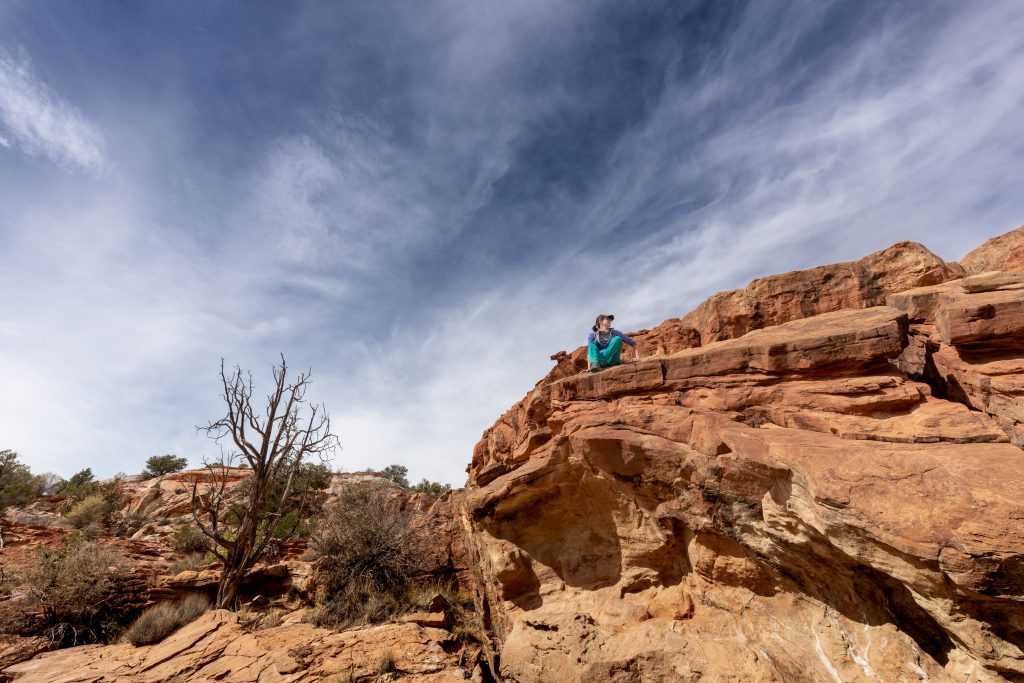
9. Don’t Climb Up What You Can’t Get Down
Often times while desert hiking you’ll find you need to use your hands while navigating canyons, washes, and boulders. This is arguably the best part of desert hiking, and really shouldn’t be missed.
However, take care. Even on looped trails, you may have to turn around, so don’t climb up anything you aren’t confident climbing back down. Downclimbing is harder than climbing up, so stay within your ability.
10. Pack it Out
The desert is one of the most sensitive environments on the planet. Life really struggles to survive here, so minimizing our impact is crucial to the survival of the landscape.
Pack an extra baggie and pack out all of your trash, including your toilet paper. Don’t leave food waste like orange rinds and apple cores behind. These aren’t found in the desert and shouldn’t be left in the desert. Also, pack out your own poop and your dog’s poop.
11. What to Do About Poop?
Human poop in the desert is actually a huge problem. Things don’t break down here – just look at the Egyptian pyramids, there are still human remains after thousands of years. Your poop is similar.
Always carry a poop bag, like a wag bag, with you while hiking in the desert. If you find yourself with the urge to go, use the bag, carry it out, and dispose of it properly (never throw those things in a pit toilet).
Wag bags have instructions and are really simple to use. They are double-lined and won’t stink, especially if you’re only out for a day. I know that pooping outdoors can be a little unnerving, but it’s really not that bad. Especially after doing it once.
Use designated pit toilets provided at campsites and trailheads. If you aren’t comfortable pooping in a bag, consider hiking in an environment where you don’t need to use bags and skipping the desert.
12. Don’t Bust the Crust
The desert has this really cool microorganism called cryptobiotic soil. Crypto, as the locals call it, is the keystone of the desert ecosystem. It breaks down waste and puts much-needed nutrients back into the sandy soil. It also stops erosion, which is a big concern to desert lift.
Don’t step on this stuff. It takes forever to grow and it’s a living, breathing thing. Killing it expedites erosion and makes life harder on plant life. It looks black/brown in color and sticks up several inches on the landscape. It can also look like little blobs of black dirt when it grows near rocks.
Stay on trails or walk around areas where the crypto grows. As we desert hikers like to stay: Don’t bust the crust!
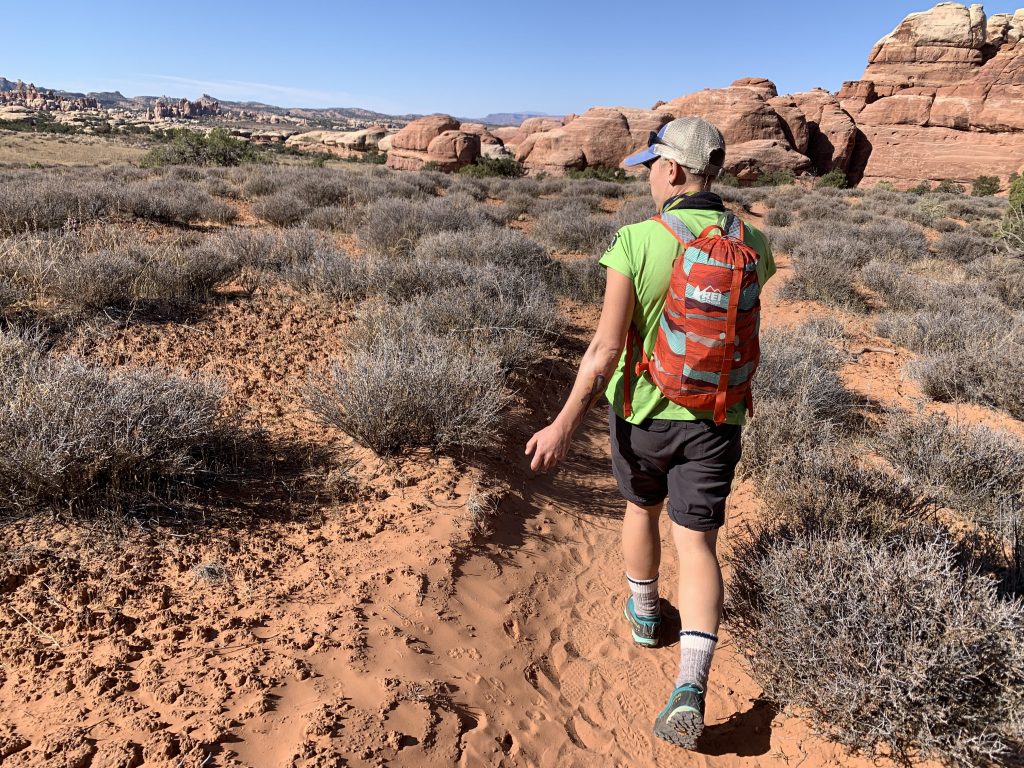
13. Desert Hiking Etiquette: Stay on the Trail
Always stick to designated trails. This not only minimizes the impact on the area, but it’s also for your safety. Everything in the desert has a defense mechanism, and even just slightly brushing a cactus can be a real problem.
Stick to designated trails when possible. If you are traveling off-trail, or there really isn’t much of a trail to begin with keep to durable surfaces, such as rocks, when possible.
14. How to Pull Out a Cactus Spine
So you accidentally gently touched a cactus. Oops! Cactus spines typically have irritating waxes or oils on them that can be itchy and cause swelling. It’s important to remove spines as quickly as possible.
Most cactus spines are barbed, so expect some resistance. First, find a clear area, then take out your tweezers. Pinch the spine with your tweezers as close to the skin as possible and gently pull. Repeat until all spines are removed, then wash the area off with alcohol wipes or iodine.
15. Leave What You Find
The desert has been home to native populations for thousands upon thousands of years. In fact, great civilizations called these places home (want to learn more? Check out my list of awesome outdoor non-fiction novels).
It’s not uncommon to stumble upon drawings and carvings in the rock, arrowheads, pot shards, and even old buildings. It is illegal to touch these items. Leave them where you found them and admire from a distance.
16. Have Some Navigation Know-How
The desert is an unforgiving place. Outside of national parks, trails are rarely marked and often follow natural contours of the landscape. You’ll often be navigating sections of trails that are ill-defined and cell service is hart to come by, so you’ll want to know how to navigate.
Understanding how to read a map and compass, as well as use a GPS are essential desert hiking skills. Don’t leave home without brushing up on that compass knowledge.
Pro Tip: Many of the features of the desert aren’t marked on a map. It’s not uncommon to come across a steep wash that doesn’t make it on the topo, be prepared and use large landmarks to navigate while on a desert hike.
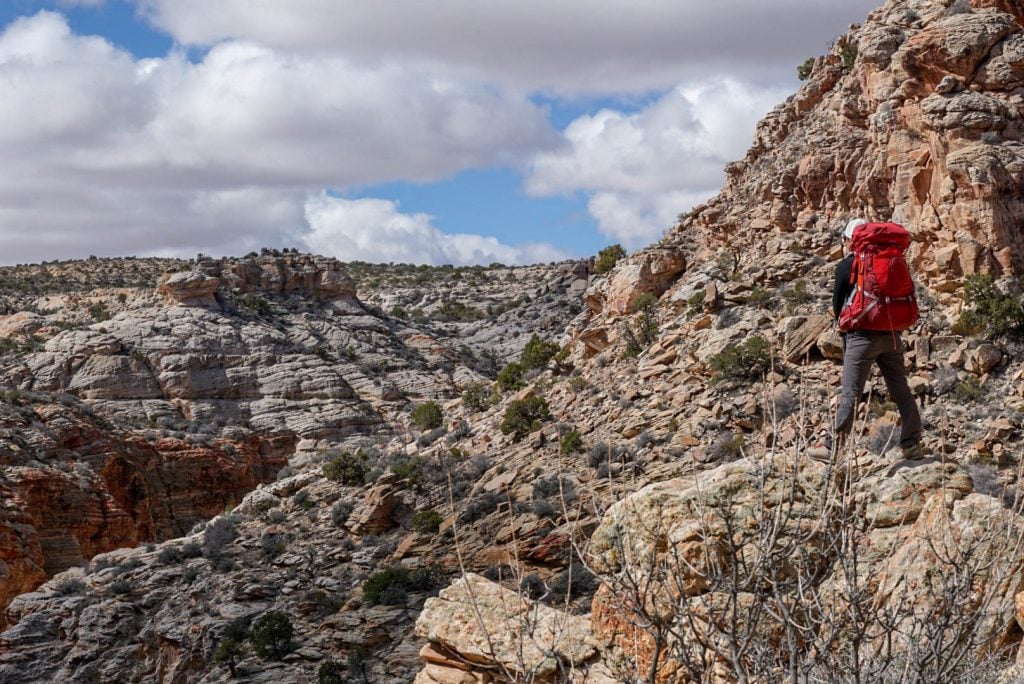
17. How to Use Cairns
A lot of people think cairns, or stacked rocks, are these fun things people build for art. That’s false, they are for navigation. If you’re traveling in a less-trafficked area, and you’re returning the way you came, you may need to build a cairn.
In the desert, make cairns small so as not to disturb the natural environment. Take care when lifting rocks as scorpions, spiders, and other crawly creatures call them home. Use them sparingly and only in situations where you don’t want to make a wrong turn. After you pass your cairn, consider putting the rocks back where you found them.
Pro Tip: Take a photo looking backward at a junction. Use your finger to point towards a landmark in the photo to aim for. This will help you navigate your way back the way you came.
18. Tell Someone Your Plan
Never travel to the desert without completing a trip plan. Tell someone what your itinerary is and what to do in case you don’t come back. Always remember to check in with your trusted contact. If you forget, have them contact you. Set up an agreed-upon time to call the authorities if they haven’t been able to reach you.
19. Watch the Weather and Avoid Rains While Hiking in the Desert
Desert weather rolls in quickly and with force. Rain is a huge threat. It can be deadly to be caught in the rain in a canyon, and hiking over muddy desert terrain is extremely taxing.
Always stay up to date with accurate weather forecasts (I use my Garmin InReach or weather.gov for pinpoint weather). Remember, storms that roll in several miles away can dump water up-canyon and still cause flooding, so check upstream of the canyon you’re traveling in.
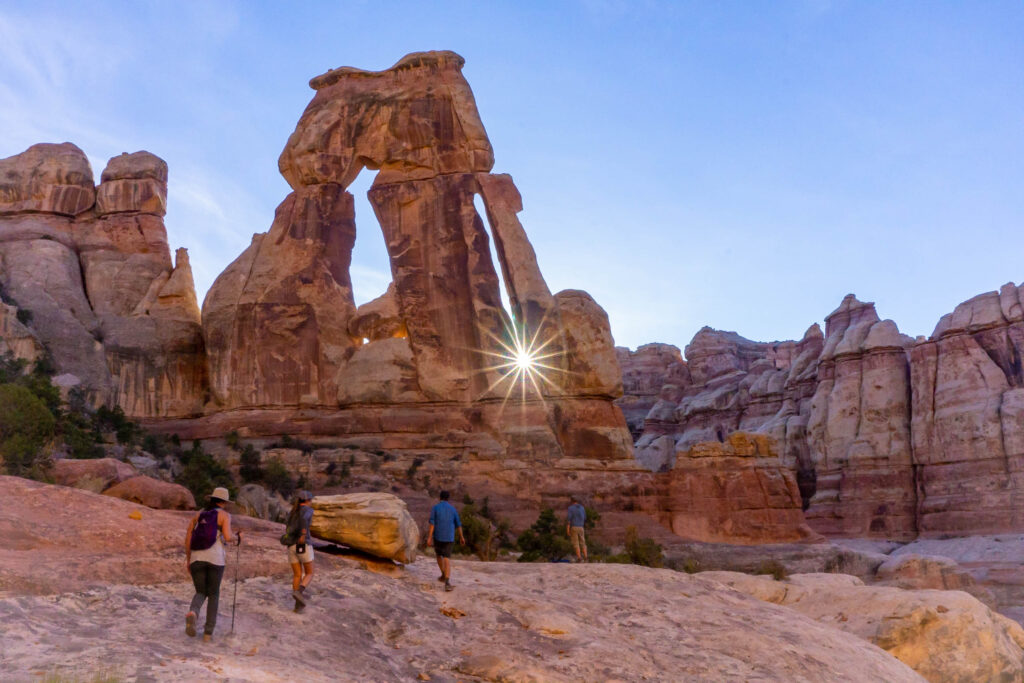
20. Can I Bring Fido on My Desert Hike?
My doggo loves the desert, but there are a few tips to keep in mind. First, never take your dog to the desert if the temperatures get above 70 degrees. I know this doesn’t sound all that hot, but temperatures on the ground are typically 10 to 15 degrees warmer.
Dogs don’t do well in the heat, so avoid taking your pup to the desert from mid-April until late October. You can kill your dog very quickly here. And heat exhaustion and heat stroke come quickly for your four-legged friends.
Also, always keep your dog on a leash. Dogs love to sniff in holes (rattlesnakes and other poisonous creatures), stop through cactus, and break up the crypto. So keep your dog leashed and on a trail at all times. Don’t forget, pack out their poop!
21. Drink Water Before and After You Hike
Hydrate up beforehand for your desert hike. You’ll feel more alert and be able to get more out of your desert hike. Start hydrating one day prior to your hike and continue to hydrate one day after to avoid delayed dehydration.
Pro Tip: Pack an icy cold cooler with some of your favorite electrolyte beverages in the car for a post-hike treat!
22. Watch Out for Wildlife
The desert may seem like a desolate place, but it’s actually teeming with wildlife. Rattlesnakes, scorpions, and tarantulas call this place home. Okay, so everyone may not like the creepy crawlies, but these animals are quite amazing but can be dangerous. Keep your distance.
If you’re hiking in the morning, be aware of snakes sunning themselves on trails. Keep your eyes open and earbuds out of your ears so you can hear their warning rattles.
Bigger creatures call the desert home. Desert bighorn sheep and pronghorn are a rare, but stunning site. Donkeys and wild horses are also known to roam the more vegetated plains of the desert. Keep your distance from these creatures, since they are skittish, and avoiding you costs them precious energy.
23. Protect Yourself from the Sun
The sun can (and will) cook you in the desert. If you don’t stay covered up and protected, you can put yourself in a dangerous situation. Be sure to wear sunscreen on your face, neck, chest, hands, and any other exposed skin. If you hike in sandals (which I don’t recommend) don’t forget to put sunscreen on your feet too.
Wear a wide-brimmed sun hat to keep your face shadded. And don’t forget sunglasses too! You can easily get headaches from straining your vision on a bright, sunny day in the desert.
Pro Tip: Invest in a lightweight sunshirt. These handy shirts wick sweat by letting the breeze through but are made from fabric that repels UV rays.
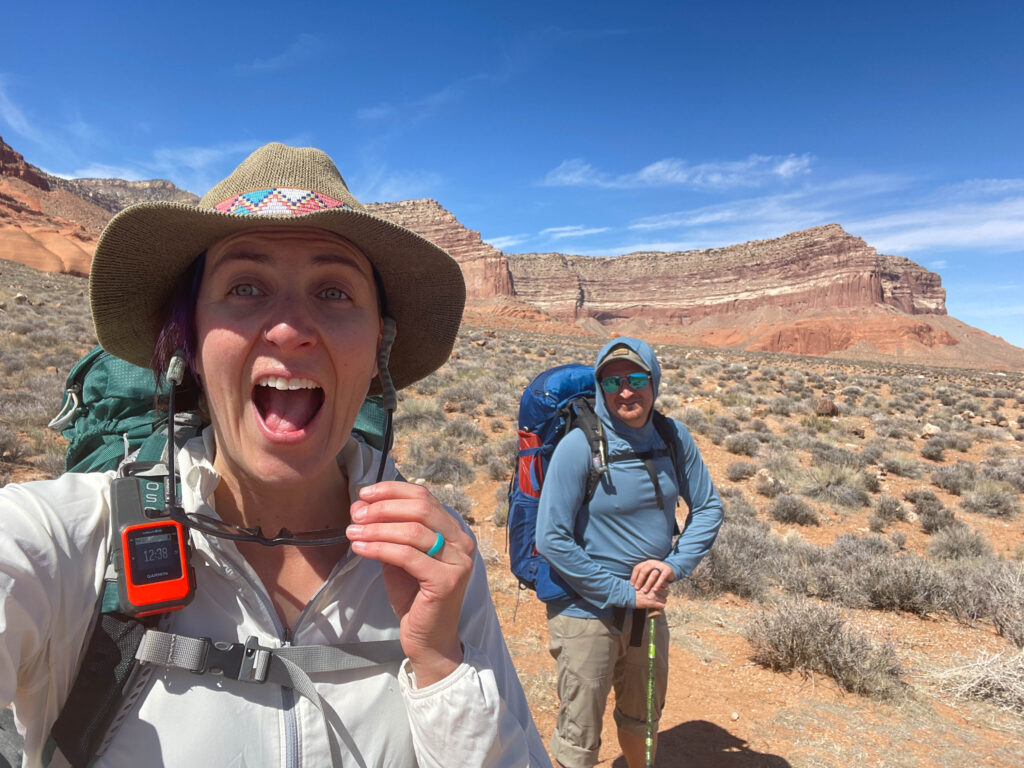
What to Wear While Hiking in the Desert?
If there’s one thing to know about the desert, it’s dress comfortable, not fashionable (if you can do both – PROPS!). Here’s what you’ll want to wear on a desert hike:
- Sturdy hiking shoes. Cover your toes to avoid bites, spines, and bumps on the rock. Approach shoes are great for scrambling rocks, but not required.
- non-cotton, breathable socks
- moisture-wicking shirt
- sunshirt (you can just rock a sunshirt with nothing underneath, but having an extra layer will be helpful if there’s a chill)
- wide brimmed hat
- Sunglasses
- Lightweight hiking pants that zip off. Shorts are okay too, just be sure to lather on the sunscreen and wear taller socks to protect your ankles from spikey plants.
- Extra layers: It’s always a good idea to pack a beanie, a jacket, and even lightweight gloves. The temperature swings in the desert are extreme, even in summer.
What is the Best Thing to Take into the Desert?
Water. Seriously. Water is a precious commodity. Often times desert hikes are in remote locations with very few services nearby. Always pack in all the water you need, and then some more in case of an emergency. Help is hard to come by and if your vehicle breaks down, you’ll want water while you wait.
Plan on at least one gallon per person per day. Use a cooler, water bottles, and water bladders to divvy up water so you can easily pack it on your hike and have some leftovers in the car. Bring electrolyte tabs to enhance flavor and keep you hydrated.
Pro Tip: You can freeze full water bottles for ice. When it melts, you’ve got delicious, refreshing, cool water to drink.
How Much Water Should I Bring Backpacking in the Desert?
Backpacking in the desert often requires a water carry, meaning you’ll carry all the water you need with you. A good general rule of thumb is to budget 1 gallon per person per day. That’s a LOT of water, but that should leave a little bit leftover for cooking and cleaning off your dusty feet at night.
In order to know how much water you’ll need, you’ll want to research the specific trail you’re hiking to get information on potential water sources. However, unless you’re hiking next to a desert river, don’t rely on seasonal water sources when planning your trip.
Pro Tip: One liter of water weighs 2.2 pounds (a little over 8 pounds per gallon). That weight adds up quickly! For longer journeys, consider caching water at waypoints, such as road crossings, ahead of time.
Get Insipred: Top Desert Hikes You Don’t want to Miss
Hiking in the desert is a magical experience as long as you are prepared. Don’t miss out on these iconic desert hikes:
- Queen’s Garden and Navajo Loop in Bryce Canyon National Park
- Overnight Backpacking to Reflection Canyon in the Glen Canyon Recreation Area
- Delicate Arch in Arches National Park
- The Cape Final Trail at the Grand Canyon
- Wire Pass to Buckskin Gulch in Vermillion Cliffs and Paria Canyon
- Little Wild Horse Canyon in the San Rafael Swell
- Spooky Slot Canyon in Escalante
- Mesa Arch at Island in the Sky District of Canyonlands National Park
- Druid Arch in the Needles of Canyonlands National Park
Amazing Desert Hiking Resources
Are you looking for a desert adventure? I’ve got several amazing resources for your next desert adventure:
- Moab’s Most Amazing Hikes
- Utah’s Top Hikes
- Arizona Hiking Trails You Can’t Miss
- Tips for Camping in the Desert Like a Pro

Now you’re ready to tackle your next desert hike with these desert hiking tips. Stay safe and enjoy this wacky, weird landscape! Happy adventures!
